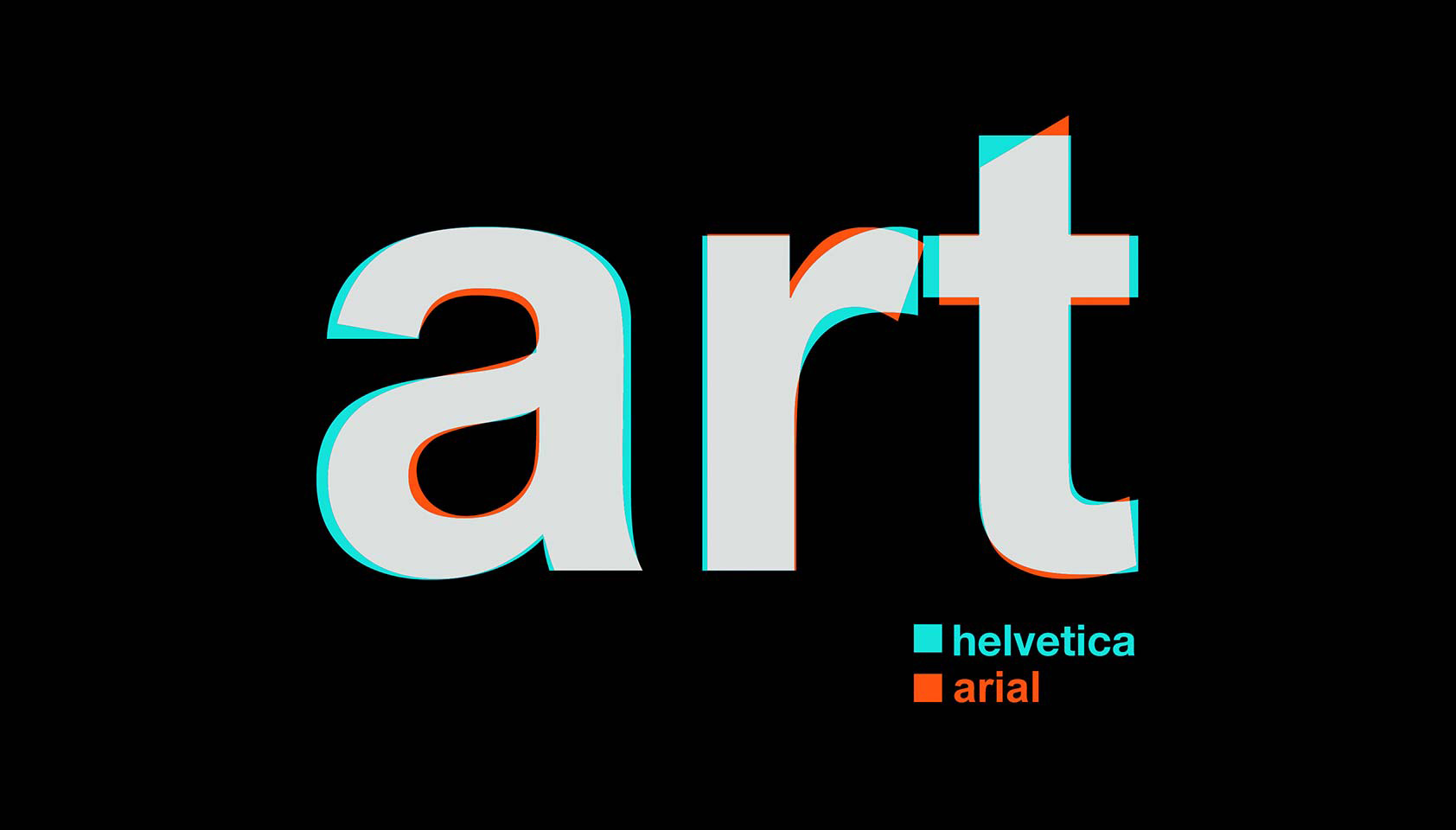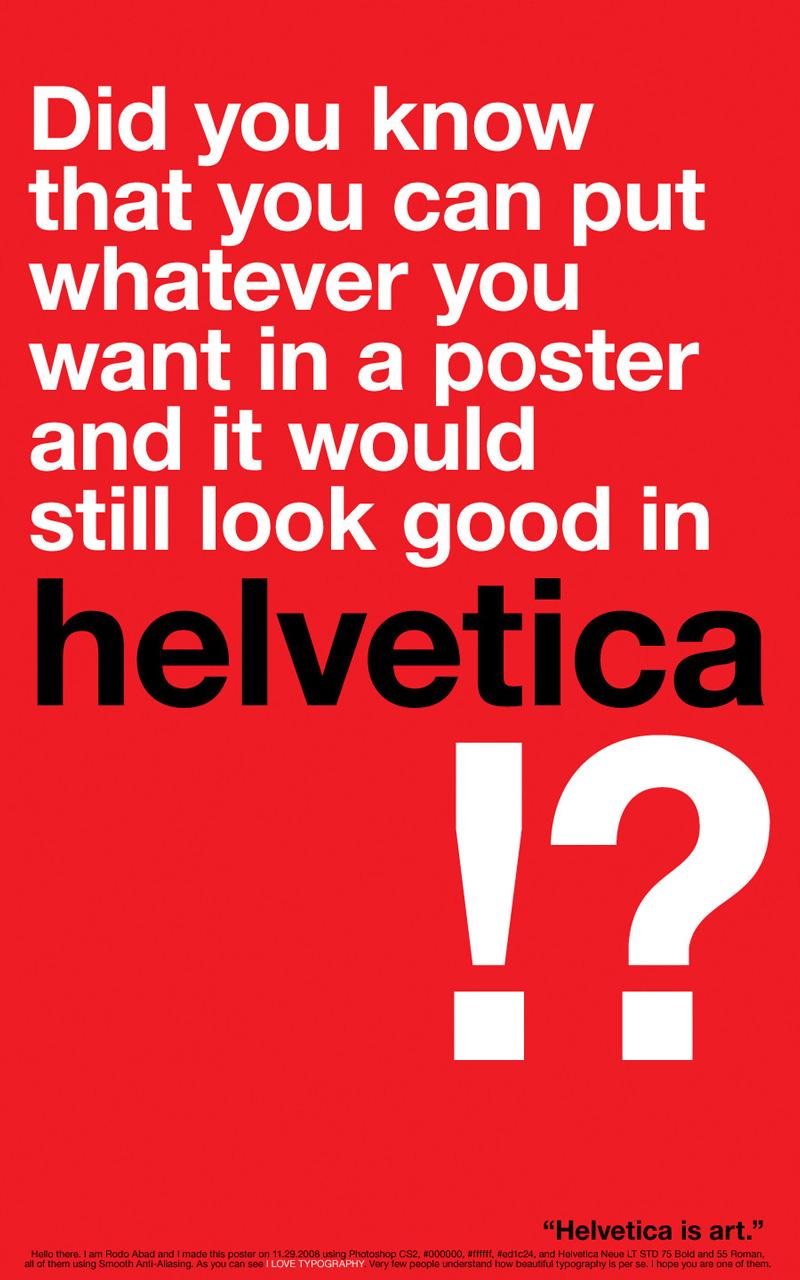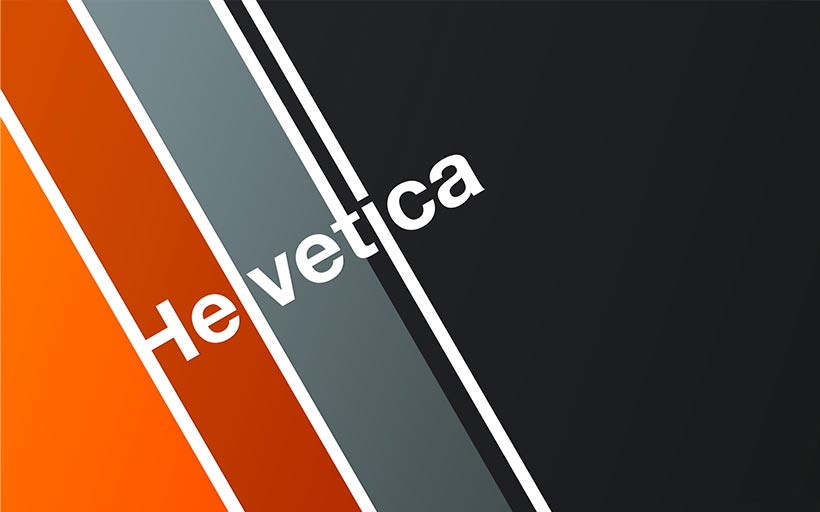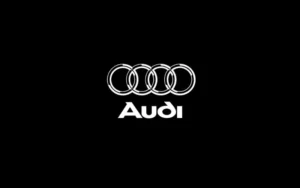Helvetica is definitively (as font geeks with a repulsive turn of phrases like to say) one of the most popular fonts of our time.
Observed from the technical aspect, Helvetica is originally a sans serif typeface, the ancestor of Berthold’s 1898 Akzidenz-Grotesk typeface.

Nowadays, the Helvetica font family can be described as ubiquitous, which is why it spells so many important brands (Nestle, Lufthansa, American Apparel, etc.). Other sectors where Helvetica is highly popular are fashion (the iconic Helvetica T-shirt writing saying ‘I hate Helvetica’) and tech producers (Intel, Apple, Microsoft, etc.).
New York’s MOMA also featured Helvetica, and the popular typeface won multiple awards and recognition because of it. The font is so popular that there is a book and a documentary movie about it.
But how does it come? How can this simple and inconspicuous font be everywhere around us?
You may not really see it, but Helvetica is there – it is on all products, websites, packages, or reading papers. Let’s check what makes it so powerful, and see whether you should use it in your upcoming design projects:
Table of contents
History Of Helvetica
As one could conclude by the name, Helvetica has Swiss origins (at first, it was called Neue Haas Grotesk, even if that probably sounds like a 1980s German factory instead of a font).
Helvetica has become one of the most popular fonts in the world. Since then it has been modified into a range of languages and variations. The typeface is currently used in many modern operating systems and other electronic displays.
It appeared in 1956, created deliberately by Eduard Hoffman and Max Miedinger to cherish the new Swiss Style, giving it extraordinary importance, almost as it was a postwar utopian mission.
While modern architecture was slowly stripping away superfluous architecture, Swiss typography followed and snipped off stone-carved and frivolous serifs. The era of modern industry was starting, and communication had to be clean and fast!
Expand your font knowledge with these insightful resources:
- Alphabet Fonts: The Ultimate Guide
- How To Use Fonts Efficiently In Web Design
- How To Choose The Right Font For Your Website
Helvetica Types & Variations
Helvetica varied many times, as a result of which there are multiple font types and variants available (Korean, Hindi, Cyrillic, Japanese, Vietnamese, Greek, and many others). The alphabet was not the only distinguishing criterion, and Helvetica soon evolved to:
- Stempel’s Helvetica Light designed by Arthur Ritzel and artistic director Erich Schultz-Anker
- Mathew Carter’s Helvetica Compressed, quite similar with Helvetica Inserat, but still not identical
- Helvetica Textbook, a product of altering characters to for informal design
- Helvetica Rounded, designed in 1978, which comprises of rounded stroke terminators. It can be used only in its black and bold version (oblique and condensed included) and has an outline version that was never available online.
- Neue Helvetica (New Helvetica), a modern 1983 version with unified character width and height. It is considered as the most legible version, due to the enlarged space between numbers and the bigger punctuation marks.
The Way To The Throne

Many experts agree that the biggest factor that influenced Helvetica’s popularity was Steve Jobs’ decision to use it as the basic font of the Apple operating system; even if the font had already become a design classic years before computers actually appeared.
As we already mentioned, the creators developed Helvetica after the war, imbuing it with a symbolic value of change for the better – a belief held by many companies. At the same time, it was a way to escape from overdone, kitschy decorated typography, and to develop unique advertisement strategies.
Companies understood Helvetica’s power to convey a professional statement and to transform their identity, right because of its modern sensibility and the sleek lines that have nothing to do with the past.
Check out: Is There A Place For Serif Fonts In The Digital Age?
Years went by, and Helvetica reaffirmed its leading corporate position, being recognized by leading businesses such as American Apparel which used the font to add playfulness to America’s corporate culture.
What is the difference between Arial and Helvetica?

Typefaces, the same as people, vary from each other due to their features. Sometimes, they look so similar that we can’t notice the difference between them, but a closer inspection would still deny the presence of casual perusal and would reveal subtle, but important differences.
In fact, they can be so tiny that one would have to take out his magnifying glass to notice them.
Check out: Best Calligraphy Fonts To Spice Up Your Writing
A good example is Arial, a typeface developed in 1982 which has incredible similarities with Helvetica. If you haven’t trained your eye to see the differences between them, you’d probably think you’re looking at the same typeface.
The dissimilarities are small, but very important, especially 3, r, t, a, R and G.

If we had to generalize, we’d say that Helvetica looks more sophisticated and refined, which would once again be difficult to notice because of the identical character width.
The reason why they are so similar is that Arial was actually created to be a competitor (following the example of Helvetica and Akzidenz-Grotesk) even if the original idea was not to design an identical twin.
Developers worked with the Monotype Grotesque® typeface to create Arial, meaning that their intention was to ‘soften’ Helvetica with fuller and rounded curves, and more open counters.
This is especially visible on the stroke ends of ‘e’, ‘g’, and ‘c’, which are not horizontally cut as in Helvetica, but are terminated naturally following the stroke direction.
Check out: Modern Fonts To Express Your Ideas

We can’t say for sure if there was a battle between the two, but Arian and Helvetica both managed to stay on the scene and to become the most popular fonts one could use nowadays.
For the sake of truth, Arial is more frequent because of being associated to Windows, while Helvetica maintains the leadership in the print design world, and is still releasing new versions and types (Linotype, for instance).
The Technicalities Of Helvetica

Observed through the technical prism, Helvetica has many interesting advantages to offer. It is the most recognized and appreciated sans serif font, and there are few good reasons for it:
- Characters always have their strokes horizontally/vertically terminated, diagonal is out of the question.
- Helvetica pays attention to the negative space around the letters, and it makes use of it to make character lines more impressive.
- The negative space visible on the ‘a’ character was a design mistake which became a popular ‘teardrop’ symbol.
- Stroke weights are monotone.
- Automakers and airlines highly appreciate Helvetica’s readability even in motion.
It will continue holding the throne because it deserves to.

Think about it: even the most innovative and passionate designers give priority to Helvetica as being good enough to become timeless. As of now, we cannot replace Helvetica. And the only trend one could expect is for Helvetica to become even more ubiquitous for every sphere.
What is certainly out of the question is that this font looks amazing, and makes use of such reputation to dominate the commercial sphere and to ‘speak’ of business. Arial is a fair substitute, not that much in terms of quality. But because of the fact that people don’t distinguish the one from the other.
Besides, Helvetica is pushing its way on Windows too. And it is more than likely to replace the far more neutral Arial typeface.

Overall, Helvetica is a good choice for those looking to write a formal and elegant piece, but also such that would prefer to balance between conservative and edgy, modern style font and traditional, or elegant and casual. This amazing font can do it all!
Generalizing once again, Helvetica tends to look more modern than classic. But that’s only because of it belonging to the sans serif family. The way it will work for you will depend on the elements you want to include. Meaning that you can use it for a more traditional scenario whenever you decide.

Meanwhile, Helvetica helps you stay on the safe side, and you can use it as your fall-back option when blowing hot and cold on particular typefaces and their impact on your design.
No wonder this font is so popular among starters and design students. They all use it for a safe ‘kick off’! Here, one must consider that Helvetica lacks the daring to complement unique projects sufficiently. And one can’t really use it to stand out from the crowd.
Check out: Beautiful Web Typography – Best Practices And Fonts To Use
Classification
Helvetica is considered a sans-serif font, which means that its letters do not have rounded tips or tails. Serif fonts, such as Times New Roman, have these types of tips and tails. Books and other printed material often use them. Sans-serif typefaces like Helvetica remain the most popular choice for websites and other digital material. Because their clean look is easier to read on screens.
Popular Usage
The Linotype corporation originally owned the rights to the Helvetica typeface. And then licensed its usage to companies like Xerox, Adobe, and Apple at the start of the personal computer revolution. The font became one of the primary typefaces in Apple’s Mac OS operating system. Until 2015, iPhones and iPads used it as the default system font.
Helvetica lost some popularity in the 1990s, as desktop publishing software became more complex and offered substitute typefaces with more variation.
Check out: Techniques To Improve Your Design Typography
Commercial Usage
Ownership of this font now sits with Monotype, the company which acquired Linotype and its assets. In order to use the font in commercialized projects, you must subscribe to a package through Monotype’s licensing system. Subscription packages are available for monthly or yearly pricing.
Large corporations like General Motors, Jeep, Target, and Verizon use this font in addition to its usage in computer operating systems and word processing software for printed branding. Transportation signage, including for the MTA in New York and the Washington DC metro system, also uses it.
Discover Pixelo’s New Free Font and Designs For Commercial Use
Similar Fonts
The official Helvetica font family includes a range of variations that offer light, bold, and compressed options. For designers looking for other Helvetica alternatives, the most common are Arial and MS Sans Serif. Both of which have gained popularity through the Microsoft Windows operating system and Office applications.
A number of license-free substitutes have also emerged in recent years. These include Nimbus Sans L, FreeSans, and Liberation Sans, which is one of the default system fonts for RedHat Linux. Google widely uses an imitation called Roboto on the Android smartphone platform, commissioned for this purpose.
Enrich your design palette with a wide range of fonts to express your unique style:
- Fonts Like Helvetica To Spruce Up Your Designs
- Modern Fonts To Express Your Ideas
- The Classy Fonts Bundle Review
- Best Calligraphy Fonts To Spice Up Your Writing
- Is There A Place For Serif Fonts In The Digital Age
Like this post? Check out more amazing web design content here.







